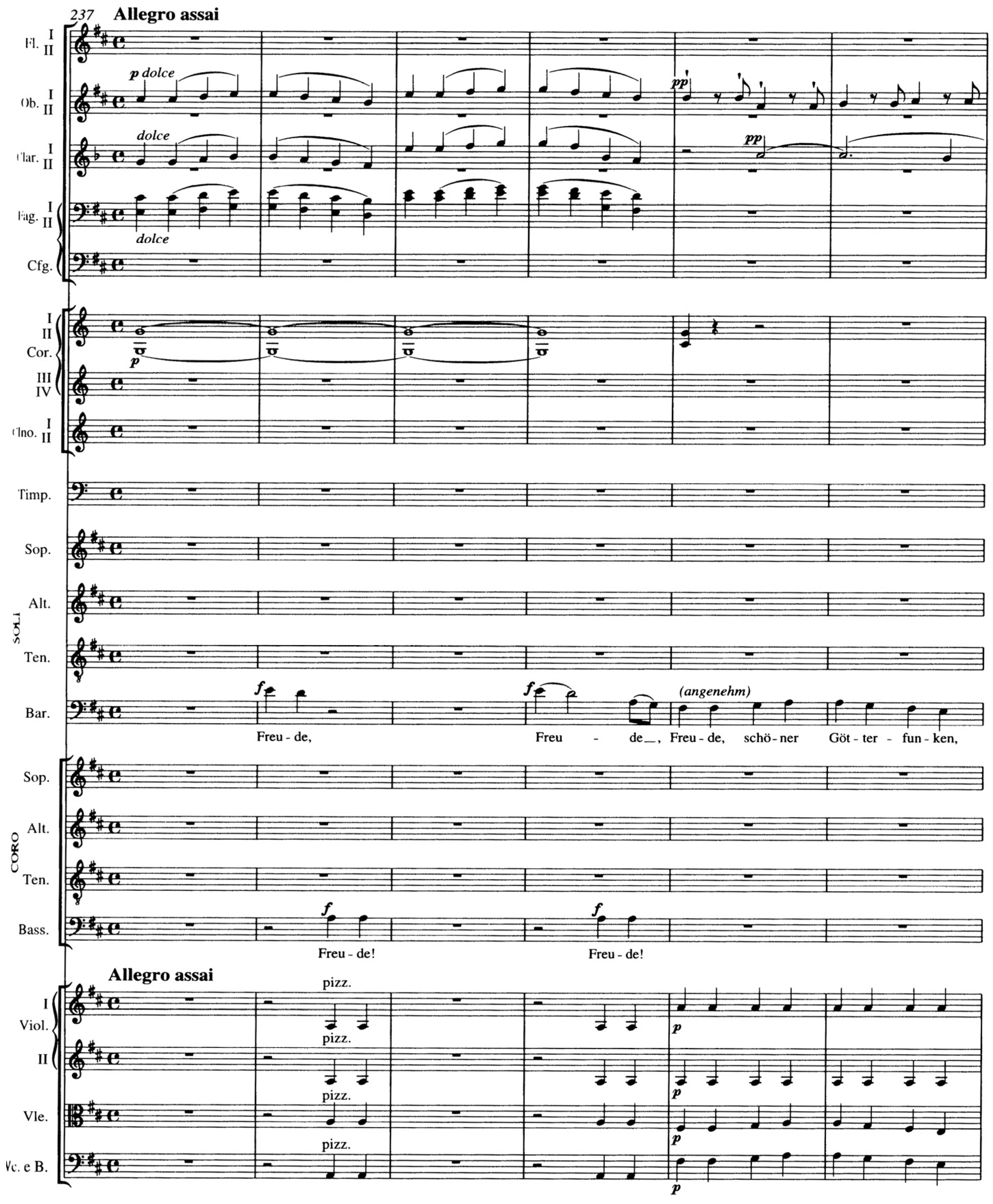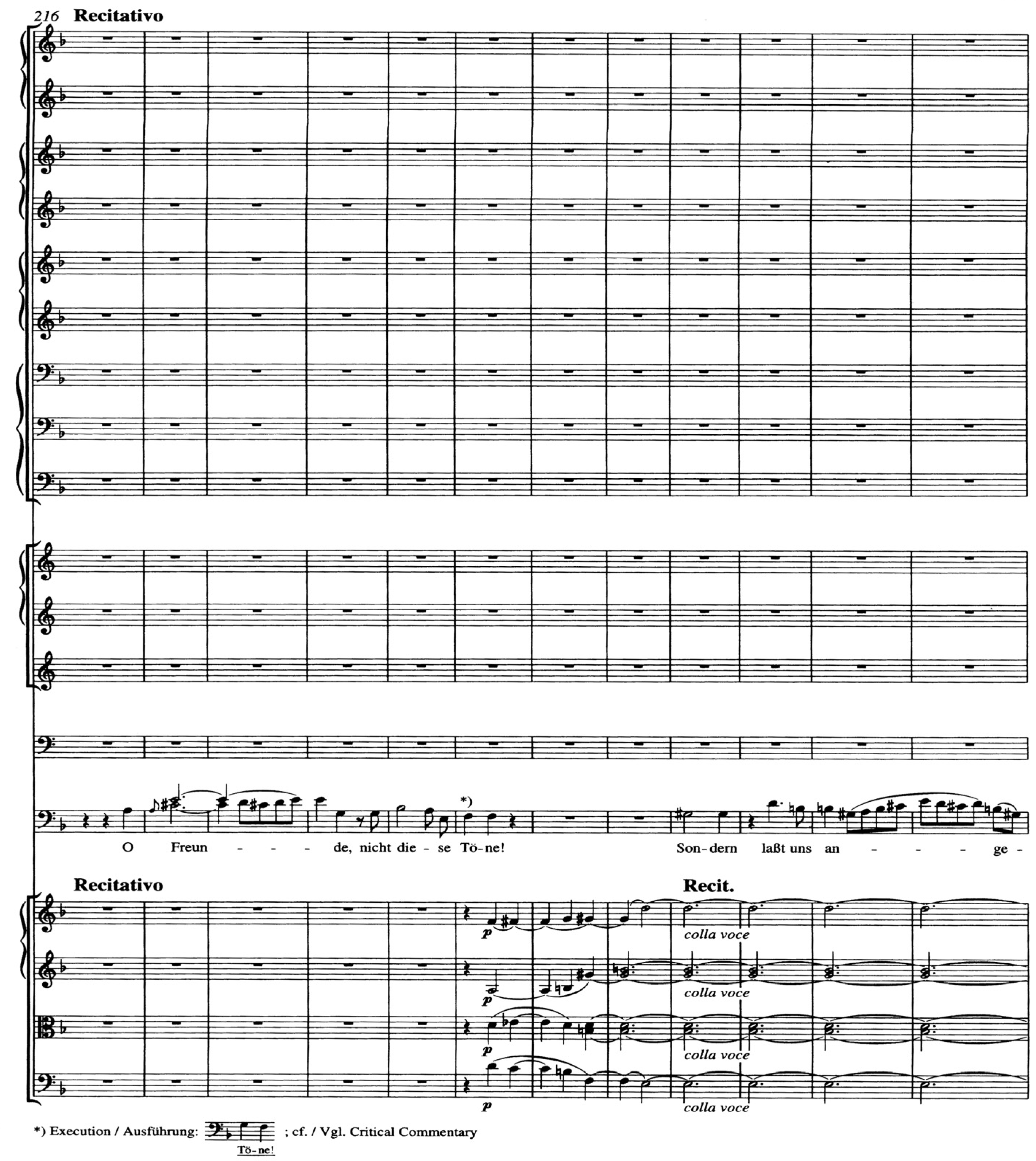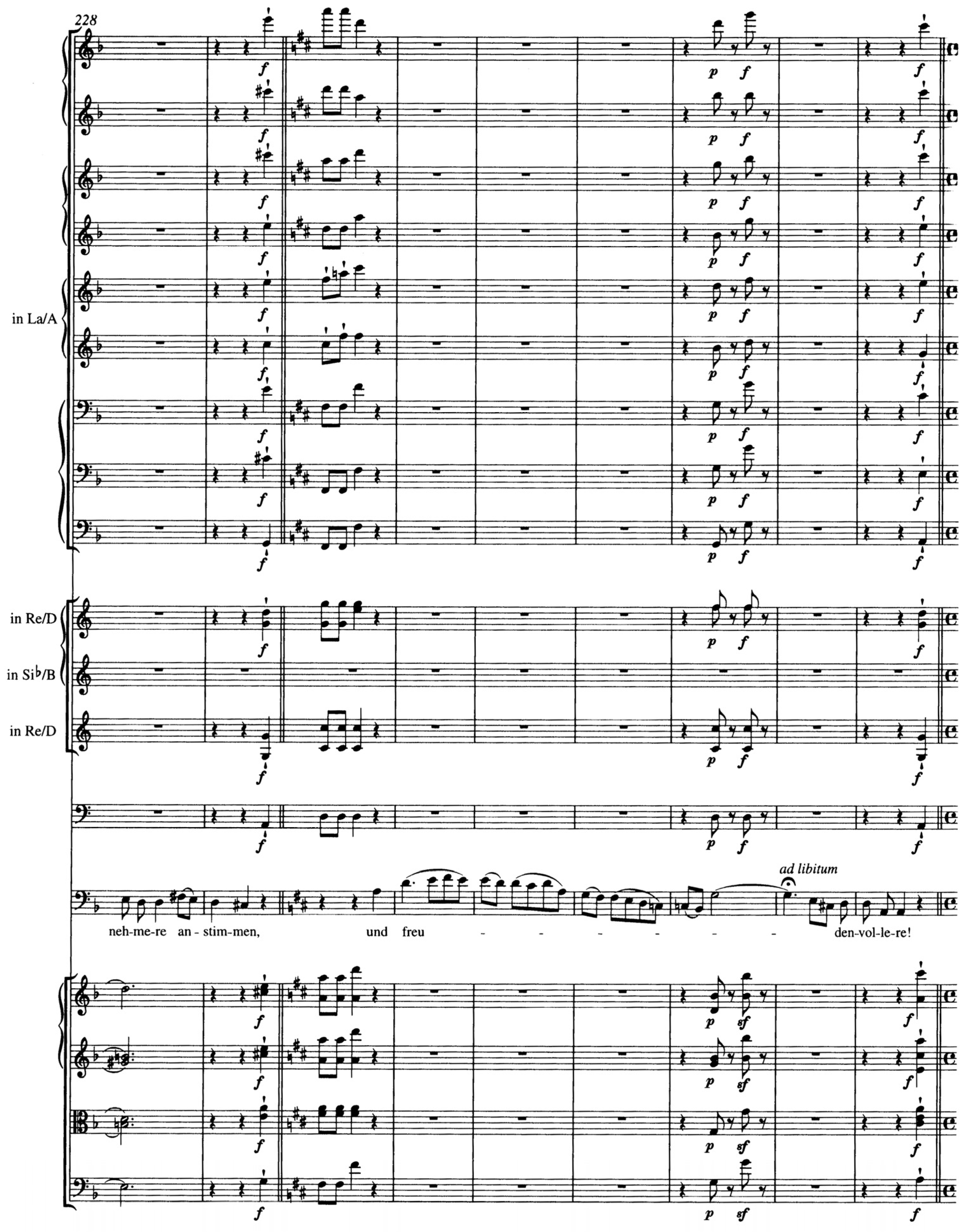The Material and “Inner Life” in Music: Beethoven, Psychological Coherence, and Meaning
Abstract
:“Setting aside the program and all peripheral verbiage, where finally are the music’s means for determinate expression? Leaving the authority of the artist out of the picture, how should we others understand their expression?”([1], p. 178).
We must respond: direct your search to art—to its material, the sounds, chords, tonal relations…, rhythms! Take to this task all the aids of simile (nehmet dazu die Hülfsmittel des Gleichnisses), symbol (Symbolik), psychological coherence (des psychologischen Zusammenhangs), all these spiritual guidelines (die geistigen Lenkfäden) that no artist and no person can do without!([1], pp. 178–79).
1. Psychological Coherence and Thought
2. Content and Form through the Lens of Psychological Coherence
3. The Creative Process and “Specific Materialization” of Psychological Coherence
Our imaginative mentality has in itself the character of universality, and what it produces acquires already thereby the stamp of universality in contrast to the individual things in nature. In this respect our imagination has the advantage that it is of wider range and therefore is capable of grasping the inner life, stressing it, and making it more visibly explicit. Now the work of art is of course not just a universal idea, but its specific materialization; but since it has been produced by spirit and its imaginative power, it must be permeated by this character of universality, even though this character has a visible liveliness.…Now here it is the task of the work of art to grasp the object in its universality and to let go, in its external appearance, everything that would remain purely external and indifferent for the expression of the content. The artist therefore does not adopt everything in the forms or modes of expression which he finds outside him in the external world and because he finds it there; on the contrary, if he is to create genuine poetry, he grasps only those characteristics which are right and appropriate to the essence of the matter in hand.([2], p. 164)
The living world of musical instruments harbours awful secrets within its bosom. What must their creator have had to endure in his fateful solitariness, imprisoned in eternal silence within his own breast! To unlock the enigma of his own interior existence there was only the enigmatic language of music—one mystery as solution to another! But he stood unbowed though profoundly shaken. What control and self-possession does this total freedom of all parts, among other things, bear witness to, each line appearing to exist in its own right alone, while yet he holds them all on course and steers them with a tight rein! What sure foundation does this perfectly stable and lucidly formed structure evince in the depth and richness of its musical ideas!...The first movement of each of the symphonies is decisive for the idea (Gedanke) of the work. In the Ninth it is more so than ever. What does it convey to us? This ceaseless complaint of eternal discontent from which he is no longer able to free himself in his kingdom of musical instruments—he who has imbued and inspired this kingdom with his creative spirits….Man is always closest to man; man’s voice is the most familiar, the most sympathetic, the most intelligible. That is a general truth….It was here that the outward plan to give the symphony a new shape by incorporating a final chorus must have become an inner necessity. What was a general truth, what was an experience peculiar of Beethoven, became now the Idea of the Ninth Symphony.([8], pp. 227–28)
4. Psychological Coherence, Beethoven’s Ninth Symphony, and Expressive Indications
4.1. The Finale



4.2. The Timpani, the Finale, and the Whole

5. Concluding Remarks
Acknowledgments
Conflicts of Interest
References
- Adolph Bernhard Marx. “Ludwig van Beethoven: Life and Works: Selected Excerpts.” In Musical Form in the Age of Beethoven: Selected Writings on Theory and Method. Scott Burnham, trans. and ed. Cambridge: Cambridge University Press, 1997, pp. 157–88. [Google Scholar]
- Georg Wilhelm Friedrich Hegel. Aesthetics: Lectures on Fine Arts. Translated by T. M. Knox. Oxford: Clarendon Press, 1975. [Google Scholar]
- Georg Wilhelm Friedrich Hegel. Encyclopedia of the Philosophical Sciences in Basic Outline, Part I: Science of Logic. Translated by Klaus Brinkmann, and Daniel O. Dahlstrom. Cambridge: Cambridge University Press, 2010. [Google Scholar]
- Adolph Bernhard Marx. Introduction to the Interpretation of the Beethoven Piano Works. Translated by Fannie Louise Gwinner. Chicago: Clayton F. Summy Co., 1895. [Google Scholar]
- Adolph Bernhard Marx. The Music of the Nineteenth Century and Its Culture: System of Musical Instruction. Translated by August Heinrich Wehrman. London: Robert Cocks and Co., 1855. [Google Scholar]
- Adolph Bernhard Marx. “Etwas über die Symphonie und Beethovens Leistungen in diesem Fache.” In Berliner Allgemeine Musikalische Zeitung. Berlin: Im Verlage der Schlesingerschen Buch- und Musikhandlung, 1824, vol. 1, pp. 165–68, 173–76, 181–84. [Google Scholar]
- Scott Burnham. “Criticism, Faith, and the ‘Idee’: A.B. Marx’s Early Reception of Beethoven.” 19th-Century Music 13 (1990): 183–92. Available online: http://www.jstor.org/stable/746446 (accessed on 1 May 2015). [Google Scholar] [CrossRef]
- Adolph Bernhard Marx. “‘[Beethoven:] The Final Symphony,’ Ludwig van Beethoven: Life and Creative Output.” In Musical Analysis in the Nineteenth Century. Ian Bent, trans. and ed. Cambridge: Cambridge University Press, 1994, vol. 2, Hermeneutic Approaches; pp. 213–37, Original published as Ludwig van Beethoven: Leben und Schaffen. Berlin: Otto Janke, 1859, vol. 2, pp. 264–88. [Google Scholar]
- Theodor W. Adorno. Beethoven: The Philosophy of Music. Edited by Rolf Tiedemann. Translated by Edmund Jephcott. Cambridge: Polity Press, 1998. [Google Scholar]
- Friedrich Schlegel. “Critical Fragments.” In Friedrich Schlegel’s Lucinde and the Fragments. Translated by Peter Firchow. Minneapolis: University of Minnesota Press, 1971, pp. 143–59. [Google Scholar]
- Richard Kramer. Unfinished Music. Oxford: Oxford University Press, 2008. [Google Scholar]
- Janet Schmalfeldt. In the Process of Becoming: Analysis and Philosophical Perspectives on Form in Early Nineteenth-Century Music. Oxford: Oxford University Press, 2011. [Google Scholar]
- Adolph Bernhard Marx. “Form in Music.” In Musical Form in the Age of Beethoven: Selected Writings on Theory and Method. Scott Burnham, trans. and ed. Cambridge: Cambridge University Press, 1997, pp. 55–90. [Google Scholar]
- Stephen Hinton. “Not Which Tones? The Crux of Beethoven’s Ninth.” 19th-Century Music 22 (1998): 61–77. Available online: http://www.jstor.org/stable/746792 (accessed on 17 August 2015). [Google Scholar] [CrossRef]
- David Benjamin Levy. Beethoven: The Ninth Symphony, revised ed. New Haven: Yale University Press, 2003. [Google Scholar]
- Richard Taruskin. “Resisting the Ninth.” 19th-Century Music 12 (1989): 241–56. Available online: http://www.jstor.org/stable/746505 (accessed on 17 August 2015). [Google Scholar] [CrossRef]
- 1.The interpretation of psychological coherence put forward here is derived from a Hegelian interpretation of psychology, i.e. rational psychology, as described in Hegel’s Encyclopedia on Logic. Hegel determines rational psychology in the following way: “it sets itself the task of knowing the spirit through thinking and also of proving what is then thought” ([3], §34, addition, p. 73).
- 2.Marx offers psychological coherence as a tool for interpretation when we remove the composer’s authority to address the content of a work of music. Therefore, the psychological coherence of a work of music will not be equivalent to the psychology of the composer where a particular quirk in a composer’s personality will speak to the inner life of a composition.
- 3.The identification of thought, ideas, and ideal content in Beethoven’s music is a recurrent theme in Marx’s discussions of music history. For example, he writes that Beethoven brought about “the spiritualization of instrumental music by raising it to the sphere of definite conceptions and ideas.” ([5], p. 84).
- 4.This is present in Marx’s review of the Ninth Symphony (see [8]) and also in the Seventh Symphony (see Scott Burnham’s description ([7], p. 191). Marx alludes to the notion that the illustration of life is fundamental to musical expression when he writes: “Music cannot define in precise terms who and what you are; but it causes all the successive emotions of your heart to pass in review before you; and these enable you to unriddle the enigma of your existence. It is both a monologue and a dialogue, full of dramatic truth and life” ([5], p. 46, translation slightly modified).
- 5.There is little room in the present article to discuss the notion of musical dialectic. Adorno has infamously linked Hegel’s dialectics with Beethoven’s work by virtue of opposing expressions, forces, or passages, constructing affines between main theme and thesis, second theme and antithesis, etc. Adorno expounds on the idea of whole as the strongest entity that illuminates the meaning of parts, where “the unity of the whole is mediated” and “not only is the individual element insignificant, but the individual moments are estranged from each other….The Beethovenian unity is one which moves by means of antitheses; this is to say its moments, taken individually, seem to contradict each other. But therein lies the meaning of Beethovenian form as process, so that although the incessant ‘mediation’ between individual moments and finally through the consummation of the form as a whole, the seemingly antithetical motifs are grasped in their identity.” (Fragment 29, p. 13) It is difficult to pin down what an antithetical theme in Hegelian logic and dialectics could look like, in the logical p / not-p relation, a notion Adorno does not directly address. Counterpoint may present a close solution, such as a theme in retrograde. Yet even a theme in retrograde has a specular relation to the main theme; it cannot sustain a p / not-p relationship because of harmonic implications, such as how to determine the meaning of a cadence in reverse. In Fragment 40, Adorno writes that in Beethoven, “the concept of negation as that which drives a process forward can be precisely grasped. It involves a breaking off of melodic lines before they have evolved into something complete and rounded in order to impel them into the next figure” ([9], p. 19).
- 6.“Many works that are praised for the beauty of their coherence have less unity than a motley heap of ideas simply animated by the ghost of a spirit and aiming at a single purpose. What really holds the latter together is that free and equal fellowship in which, so the wise men assure us, the citizens of the perfect state will live at some future date; it’s that unqualifiedly sociable spirit which, as the beau monde maintains, is now to be found only in what is so strangely and almost childishly called the great world. On the other hand, many a work of art whose coherence is never questioned is, as the artist knows quite well himself, not a complete work but a fragment, or one or more fragments, a mass, a plan. But so powerful is the instinct for unity in mankind that the author himself will often bring something to a kind of completion which simply can’t be made a whole or a unit; often quite imaginatively and yet completely unnaturally. The worst thing about it is that whatever is draped about the solid, really existent fragments in the attempt to mug up a semblance of unity consists largely of dyed rags. And if these are touched up cleverly and deceptively, and tastefully displayed, then that’s all the worse. For then he deceives even the exceptional reader at first, who has a deep feeling for what little real goodness and beauty is still to be found here and there in life and letters. That reader is then forced to make a critical judgment to get at the right perception of it! And no matter how quickly the dissociation takes place, still the first fresh impression is lost” ([10], §103, p. 155).
- 7.Richard Kramer writes at length about the interpretation of fragmented and unfinished works in light of Schlegel’s theory of fragments. I argue that in Schlegel’s Fragment 103 of the Critical Fragments, Schlegel understands even a finished work to be fragmentary, or unfinished. I find he refers also to the creative impulse, where a composer may always see imperfection and room for improvement in a musical work that is “finished.” For Richard Kramer’s account see ([11], pp. 311–44). One of Kramer’s claims is that musical fragments offer a vision of the creative process or a composer’s thought. With relation to Mozart’s fragment, String Quartet in G minor, K 587a (Anhang 74), he writes on the final, partial phrase found in mm. 24–5: “The inclination to complete this unfinished phrase confronts us with the ultimate riddle of the fragment as a species, for it assumes access to a process of mind that is unfathomable even within itself. It is not the harmonization of the phrase, or even the logical next step in its unfolding, that is at question, but a prior matter having to do with the imponderables of the mind that could give us this phrase with one hand and take it back with the other” ([11], p. 316).
- 8.Janet Schmalfeldt describes the process of becoming, synthesis, and dialectic with relation to Beethoven. She achieves this namely through a presentation of views by Theodor Adorno and Carl Dahlhaus along with her interpretation of their ideas. In one example, she cites Adorno’s theory of multidimensional hearing that allows us to hear forward and backward at the same time. In spite of this, we find that a composition’s form will condition Adorno’s progressive view of hearing (see [12], pp. 23–57, viz. p. 32).
- 9.The individuality of a musical fragment can be observed when opera arias are sung at recitals. In these cases, the performer is able to grant coherence to a particular song through performance interpretation even when the meaning of the aria in the dramatic context of the opera is lost.
- 10.As Hegel describes, from the perspective of an “anatomist who has to deal no longer with living bodies but with cadavers” ([7], §135, Addition, p. 203).
- 11.Marx describes how sonata form embodies an aspect of content in the following: “If the artist has experienced a deeper transformation within himself and then turns his gaze from his interior submersion back out into the world, then even the world itself will seem foreign and alienating to him. He knew it before and recognizes it again—and it appears as an Other to him, for he has become other. This schism, softened by the feeling of his own elevation and ascendancy over that which has become alien, finds its expression in the humor of the scherzo (the final movement of a sonata)” ([13], p. 87). Marx describes an ideal artist in this passage (although not entirely explicit, Marx appears to be thinking of Beethoven), and sonata form is consequently based on the coherence that emerges from psychological evolution. The psychological evolution we encounter in the changing movements of a sonata will assist in our ability to establish psychological coherence of content, even though these are not identical.
- 12.It seems dangerous to bring Friedrich Schlegel’s concept of irony to bear on the negation expressed in the baritone’s recitative (see [14], pp. 75–77). Schlegel’s irony tends to turn meaning on its head, with arguments rooted in ultimate expressions of Fichtean ego and subjectivity. Hegel describes the spiral of negation that comes with this irony: “The ironical, as the individuality of genius, lies in the self-destruction of the noble, great, and excellent; and so the objective art-formations too will have to display only the principle of absolute subjectivity, by showing forth what has worth and dignity for mankind as null in its self-destruction. This then implies that not only is there to be no seriousness about laws, morals, and truth, but that there is nothing in what is lofty and best, since, in its appearance in individuals, characters, and actions, it contradicts and destroys itself and so is ironical about itself” ([2], p. 67). One way to counter the irony argument is to show that despite the symphony’s expressions of unrest, which are metaphorically parallel to aspects of Beethoven’s life, Marx is able to construct an Idee within the Ninth Symphony (and thus assert the presence of universal content). The universality of meaning locked within this symphony, and the diverse interpretations it affords, suggests that subjectivity and ego are far from the baritone’s words.
- 13.The last beat of measure 215, not shown, is a rest in all instruments. The lack of dynamics is rather unremarkable, as the vocal parts in recitatives generally do not have dynamics written into the part; measure 238 does provide dynamic indications that call attention to the opposition between the voices and the other instrumental parts.
- 14.“The kettledrums in m. 5–tuned in a most unorthodox way to octave Fs–leave no doubt that the present movement is in D minor. This tuning–the same Beethoven used in the finale of his Eighth Symphony–is as unexpected as it is audacious” ([15], p. 70).
- 15.See ([15], pp. 69–70).
© 2015 by the authors; licensee MDPI, Basel, Switzerland. This article is an open access article distributed under the terms and conditions of the Creative Commons Attribution license (http://creativecommons.org/licenses/by/4.0/).
Share and Cite
Eckerson, S. The Material and “Inner Life” in Music: Beethoven, Psychological Coherence, and Meaning. Humanities 2015, 4, 418-435. https://doi.org/10.3390/h4030418
Eckerson S. The Material and “Inner Life” in Music: Beethoven, Psychological Coherence, and Meaning. Humanities. 2015; 4(3):418-435. https://doi.org/10.3390/h4030418
Chicago/Turabian StyleEckerson, Sara. 2015. "The Material and “Inner Life” in Music: Beethoven, Psychological Coherence, and Meaning" Humanities 4, no. 3: 418-435. https://doi.org/10.3390/h4030418




